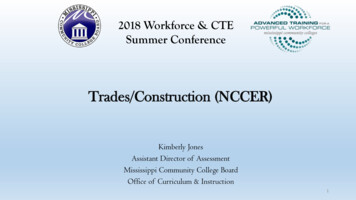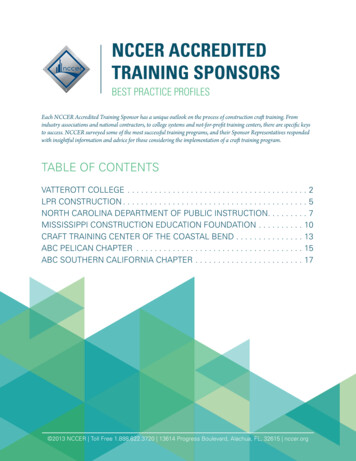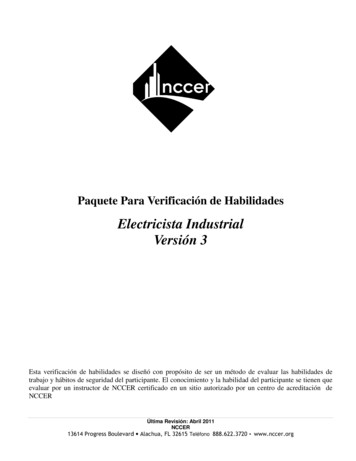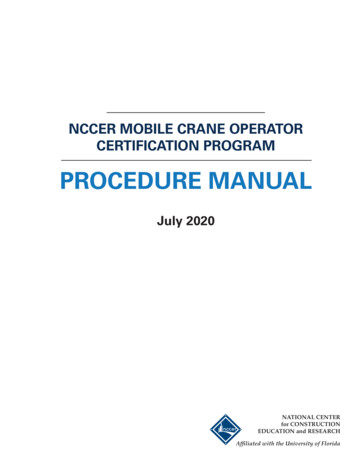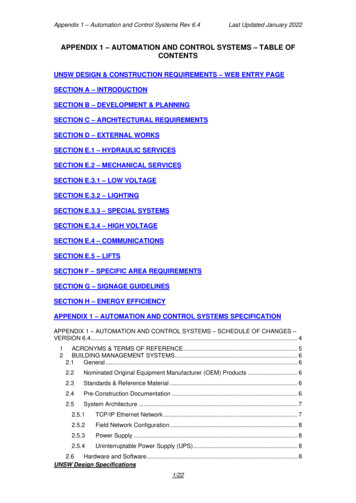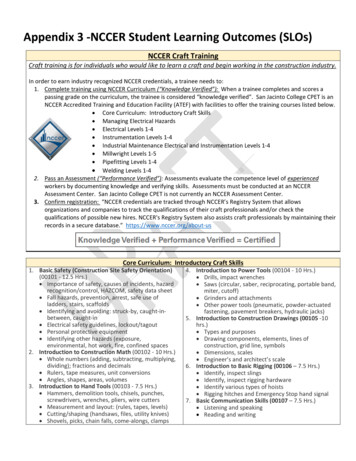
Transcription
Appendix 3 ‐NCCER Student Learning Outcomes (SLOs)NCCER Craft TrainingCraft training is for individuals who would like to learn a craft and begin working in the construction industry.In order to earn industry recognized NCCER credentials, a trainee needs to:1. Complete training using NCCER Curriculum (“Knowledge Verified”): When a trainee completes and scores apassing grade on the curriculum, the trainee is considered “knowledge verified”. San Jacinto College CPET is anNCCER Accredited Training and Education Facility (ATEF) with facilities to offer the training courses listed below. Core Curriculum: Introductory Craft Skills Managing Electrical Hazards Electrical Levels 1‐4 Instrumentation Levels 1‐4 Industrial Maintenance Electrical and Instrumentation Levels 1‐4 Millwright Levels 1‐5 Pipefitting Levels 1‐4 Welding Levels 1‐42. Pass an Assessment (“Performance Verified”): Assessments evaluate the competence level of experiencedworkers by documenting knowledge and verifying skills. Assessments must be conducted at an NCCERAssessment Center. San Jacinto College CPET is not currently an NCCER Assessment Center.3. Confirm registration: “NCCER credentials are tracked through NCCER’s Registry System that allowsorganizations and companies to track the qualifications of their craft professionals and/or check thequalifications of possible new hires. NCCER's Registry System also assists craft professionals by maintaining theirrecords in a secure database.” https://www.nccer.org/about‐usCore Curriculum: Introductory Craft Skills1. Basic Safety (Construction Site Safety Orientation)(00101 ‐ 12.5 Hrs.) Importance of safety, causes of incidents, hazardrecognition/control, HAZCOM, safety data sheet Fall hazards, prevention, arrest, safe use ofladders, stairs, scaffolds Identifying and avoiding: struck‐by, caught‐in‐between, caught‐in Electrical safety guidelines, lockout/tagout Personal protective equipment Identifying other hazards (exposure,environmental, hot work, fire, confined spaces2. Introduction to Construction Math (00102 ‐ 10 Hrs.) Whole numbers (adding, subtracting, multiplying,dividing); fractions and decimals Rulers, tape measures, unit conversions Angles, shapes, areas, volumes3. Introduction to Hand Tools (00103 ‐ 7.5 Hrs.) Hammers, demolition tools, chisels, punches,screwdrivers, wrenches, pliers, wire cutters Measurement and layout: (rules, tapes, levels) Cutting/shaping (handsaws, files, utility knives) Shovels, picks, chain falls, come‐alongs, clamps4. Introduction to Power Tools (00104 ‐ 10 Hrs.) Drills, impact wrenches Saws (circular, saber, reciprocating, portable band,miter, cutoff) Grinders and attachments Other power tools (pneumatic, powder‐actuatedfastening, pavement breakers, hydraulic jacks)5. Introduction to Construction Drawings (00105 ‐10hrs.) Types and purposes Drawing components, elements, lines ofconstruction, grid line, symbols Dimensions, scales Engineer’s and architect’s scale6. Introduction to Basic Rigging (00106 – 7.5 Hrs.) Identify, inspect slings Identify, inspect rigging hardware Identify various types of hoists Rigging hitches and Emergency Stop hand signal7. Basic Communication Skills (00107 – 7.5 Hrs.) Listening and speaking Reading and writing
NCCER Managing Electrical Hazards (26501‐15)1. Managing electrical hazards (8‐12 hrs.) Identify electrical hazard types and locations. Explain related safety guidelines and terms. Recognize and explain hazard boundaries. Explain employer and employee responsibilities in recognizing and managing electrical hazards. Identify common factors that lead to electrical incidents and explain the importance of using good judgement,appropriate procedures, and safe work practices. Analyze the electrical hazards of a given task, plan the job, and complete an electrical work permit request. Select, inspect, and maintain personal protective equipment (PPE) and test equipment used for electrical work. Explain how to create an electrically safe work condition.NCCER Electrical Level 18. Orientation to the Electrical Trade (2.5 Hrs.) Overview of the electrical trade Career paths available to electricians.9. Electrical Safety (10 Hrs.) Safety rules and regulations for electricians Precautions for electrical hazards found on the job. OSHA‐mandated lockout/tagout procedure.10. Introduction to Electrical Circuits (7.5 Hrs.) Ohm’s law applied to DC series circuits. Atomic theory, electromotive force, resistance,and electric power equations.11. Electrical Theory (7.5 Hrs.) Series, parallel, and series parallel circuits. Resistive circuits, Kirchhoff’s voltage and current laws Circuit analysis.12. Introduction to the National Electrical Code (7.5Hrs.) Road map for using the NEC . Layout and the types of information found withinthe code book. Finding information using an easy‐to‐followprocedure.13. Device Boxes (10 Hrs.) Hardware and systems used by an electrician tomount and support boxes, receptacles, and otherelectrical components. NEC fill and pull requirements for device, pull,and junction boxes under 100 cubic inches.14. Hand Bending (10 Hrs.) Conduit bending and installation. Techniques for using hand‐operated and stepconduit benders, Cutting, reaming, and threading conduit.15. Raceways and Fittings (20 Hrs.) Types and applications of raceways, wireways, andducts. Applicable NEC requirements.16. Conductors and Cables (10 Hrs.) Types and applications of conductors Proper wiring techniques. Stresses the applicable NEC requirements.17. Basic Electrical Construction Drawings (7.5 Hrs.) Electrical prints, drawings, and symbols, Information that can be found on schematics, one‐lines, and wiring diagrams.18. Residential Electrical Services (15 Hrs.) Electrical devices and wiring techniques commonto residential construction and maintenance. Service calculations. Applicable NEC requirements.19. Electrical Test Equipment (5 Hrs.) Selection, inspection, and use of common electricaltest equipment: voltage testers, clamp‐onammeters, ohmmeters, multimeters, phase/motorrotation testers, and data recording equipment. Safety precautions and meter category ratings.
NCCER Electrical Level 21. Alternating Current (17.5 Hours) Forces characteristics of alternating‐currentsystems Application of Ohm’s law to AC circuits.2. Motors: Theory and Application (20 Hours)o Covers AC and DC motors, including the maincomponents, circuits, and connections.3. Electric Lighting (15 Hours)o Introduces principles of human vision and thecharacteristics of light. Focuses on the handlingand installation of various types of lamps andlighting fixtures.4. Conduit Bending (15 Hours)o Bends in conduit up to 6 inches.o Mechanical, hydraulic, and electrical benders.5. Pull and Junction Boxes (12.5 Hours)o Selecting and sizing pull boxes, junction boxes, andhandholes.6. Conductor Installations (10 Hours)o Transportation, storage, and setup of cable reels;o Procedures for complete cable pulls in racewaysand cable trays. Methods of rigging7. Cable Tray (7.5 Hours) Focuses on NEC installation requirements forcable tray and cable installations.8. Conductor Terminations and Splices (7.5 Hours)o Terminating and splicing conductors,o Preparing and taping conductors.9. Grounding and Bonding (15 Hourso Grounding and bonding electrical systems.o NEC requirements.10. Circuit Breakers and Fuses (12.5 Hours)o Practical applications of fuses and circuit breakers.o Fuse and breaker sizing.11. Control Systems and Fundamental Concepts (12.5Hours)o Descriptions of contactors and relayso Practical application of contactors and relaysNCCER Electrical Level 31. Load Calculations: Branch and Feeder Circuits (17.5Hours)o Calculating branch circuit and feeder loads forresidential and commercial applications.2. Conductor Selection and Calculations (15 Hours)o Factors involved in conductor selection, insulationtypes, current‐carrying capacity, temperatureratings, and voltage drop.3. Practical Applications of Lighting (12.5 Hours)o Describes specific types of incandescent,fluorescent, and HID lamps, and ballasts.o Troubleshooting and various types of lightingcontrols.4. Hazardous Locations (15 Hours)o NEC requirements for equipment installed inhazardous locations.5. Overcurrent Protection (25 Hours)o Sizing and selecting circuit breakers and fuses forvarious applications. Short circuit calculations and troubleshooting.6. Distribution Equipment (12.5 Hours)o Overview of switchboards and switchgear,o Grounding and maintenance requirementso Review of drawings.7. Transformers (12.5 Hours)o Covers transformer types, construction,connections, protection, and grounding.8. Commercial Electrical Services (10 Hours)o Covers components, installation, andconsiderationso NEC requirements for commercial services.9. Motor Calculations (12.5 Hours)o Covers calculations required to size conductorsand overcurrent protection for motor applications.10. Voice, Data, and Video (10 Hours)o Covers installation, termination, and testing ofvoice, data, and video cabling systems.11. Motor Controls (12.5 Hours)o Selecting, sizing, and installing motor controllers Control circuit pilot devices and basic relay logic.
NCCER Electrical Level 41. Load Calculations: Feeders and Services (20 Hours)Basic calculation procedures for commercial andresidential applications.2. Health Care Facilities (10 Hours)o Installation of electric circuits in health carefacilitieso Requirements for life safety and critical circuits.3. Standby and Emergency Systems (10 Hours)o NEC requirements for electric generators andstorage batteries.4. Basic Electronic Theory (10 Hours)o The function and operation of basic electronicdevices, including semiconductors, diodes,rectifiers, and transistors.5. Fire Alarm Systems (15 Hours)o Fire alarm control unitso Digital Alarm Communicator Systemso Wiring for alarm initiating and notification deviceso Alarm system maintenance6. Specialty Transformers (10 Hours)o Types of transformers and their applicationso Selecting, sizing, and installing these devices.7. Advanced Controls (20 Hours)o Applications and operating principles of solid‐statecontrols, reduced‐voltage starters, and adjustablefrequency drivesBasic troubleshooting procedures.8.HVAC Controls (15 Hours)o Basic overview of HVAC systems and controls.o Electrical troubleshooting and NEC requirements.9. Heat Tracing and Freeze Protection (10 Hours)o Heat tracing systems application and installationrequirements.10. Motor Operation and Maintenance (10 Hours)o Motor cleaning, testing, and preventivemaintenance.o Basic troubleshooting procedures.11. Medium‐Voltage Terminations/Splices (10 Hours)o Overview of the NEC and cable manufacturers’requirements for medium‐voltage terminationsand splices.12. Special Locations (20 Hours)o NEC requirements for selecting and installingequipment, enclosures, and devices in speciallocations including places of assembly, theaters,carnivals, agricultural buildings, marinas,temporary installations, wired partitions, andswimming pools.13. Fundamentals of Crew Leadership (20 Hours)NCCER Instrumentation Level 11. Orientation to the Trade (2.5 hrs.) Typical work of instrument fitters and technicians Responsibilities and required aptitudes. Apprenticeship process and career paths2. Instrumentation Safety Practices (12.5 hrs.) Precautions for electrical hazards found on the job. OSHA‐mandated lockout/tagout procedure. Safety practices related to potentially hazardoustools and materials.3. Hand and Power Tools for Instrumentation (15 hrs.) Identify, inspect, use, and maintain hand andpower tools4. Craft‐Related Mathematics (10 hrs.) Metric system Conversion of English units to metric units. Basic algebra, geometric figures, trianglecalculations5. Instrumentation Drawings, Documents ‐ 1 (15 hrs.) Types of drawings used in instrumentation work Basic instrument symbols, lines, and abbreviations6. Inspect, Handle, and Store InstrumentationMaterials (2.5 hrs.) Receiving, inspecting, handling, and storingproject‐related instrumentation equipment.7. Electrical Systems for Instrumentation (12.5 hrs.) Basic electrical concepts and terms. DC circuit calculations. Electrical measuring instruments and wiring8. Fasteners (7.5 Hrs.) Identify, select, and install threaded and non‐threaded fasteners and anchors9. Gaskets and Packing (7.5 hrs.) Recognize, select, and properly install gaskets,packing, and O‐rings. Materials used in gaskets and O‐rings Applications and limitations.10. Lubricants, Sealants, and Cleaners (7.5 Hrs.) Proper use, storage, handling, and safety practicesassociated with various lubricants, cutting fluids,sealants, and cleaners. Tools and materials used in applying lubricants andcleaning products.11. Tubing (15 Hrs.) Tubing, tubing materials, fittings, and tools. Storage, handling, cutting, deburring, reaming,bending, and joining of tubing.12. Steel Piping Practices (10 Hrs.) Carbon and stainless steel piping measuring 2” asit applies to instrumentation work. Calculating pipe cut length, cutting, deburring,reaming, and threading pipe.13. Hoses (7.5 Hrs.) Hoses and related fittings Storage and handling. Cutting hoses and installing standard reusablefittings.
NCCER Instrumentation Level 21. Craft‐Related Mathematics(15 hrs.) Mass, weight, pressure, temperature, and flow Conversion of units Application to instrumentation.2. Instrumentation Drawings, Documents ‐ 2 (20 hrs.) Piping and instrumentation drawings, loop sheets, flow diagrams, isometrics and orthographics.3. Principles of Welding for Instrumentation (10 hrs.) Welding procedure for instrument installation Basic techniques and applications Safety precautions Equipment, Brazing and welding procedures.4. Process Control Theory (20 hrs.) Operation of control systems Common modes of control; advantages anddisadvantages. Fundamentals and types of controls, individual components and their roles in typicalcontrol loops.5. Detectors, Secondary Elements, Transducers, andTransmitters (20 hrs.) Instrumentation elements; operation principles Variables measured by each element Device selection technical manuals, specificationsheets, pictures, or actual samples.6. Controllers, Recorders, and Indicators (10 hrs.) Theory of operation and application Pneumatic and electronic equipment.7. Control Valves, Actuators, and Positioners (15 hrs.) Construction, operation, and use Identification and selection of control valves usingapplicable specifications and schematics.8. Relays and Timers (7.5 hrs.) Principles of operation, variables measured Selection using specification sheets or samples.9. Switches and Photoelectric Devices (5 hrs) Principles of operation, variables measured Device selection using specification sheets orsamples.10. Filters, Regulators, and Dryers (7.5 hrs.) Construction, operation, and uses Selection using applicable specifications andschematics.11. Analyzers and Monitors (5 Hrs.) Instrumentation used to sample, analyze, and/ormonitor industrial processes Principles of operation. Selection using technical manuals, specificationsheets, pictures, or actual equipment samples.12. Panel‐Mounted Instruments (7.5 hrs.) Selection of instruments Locating the instruments using drawings, Procedures for installations13. Installing Field‐Mounted Instruments (25 hrs.) Selection and mounting of instruments atlocations other than panels, including standmounting, in‐line mounting, structuremounting, strap mounting, and insertionmounting.14. Raceways for Instrumentation (17.5 hrs.) Identification and selection of conduit, raceways,wireways, cable trays, fittings NEC requirements for installation.NCCER Instrumentation Level 31. Control Valves, Actuators, and Positioners (15 hrs.) Construction and operation Application and operation of valve positioners. Valve selection criteria; valve and actuatormarkings and nameplate information.2. Detectors, Secondary Elements, Transducers, andTransmitters (25 hrs.) Detecting different process variables, Converting variables into transmittable form, Transmitting the information to another device forcontrol or informational purposes. Sensing flow, level, temperature, and pressure, Various types of transducers and transmitters.3. Instrumentation Electrical Circuitry (25 hrs.) Series and parallel circuits; resistance, inductance, capacitance in AC circuits; DC power supplies; analog and digital signals; Applications of electrical/electronic circuitry.4. Relays and Timers (10 Hrs.) Principles of operation and applications Selection process.5. Switches and Photoelectric Devices (10 Hrs.) Principles of operation and applications6. Terminating Conductors (20 Hrs.) Methods, procedures, and standards used toterminate and test common types of conductors7. Grounding, Shielding of Wiring (10 hrs.) Grounding, shielding; wire and cable identification. Induced noise and methods to reduce or eliminate8. Process Control Theory (25 Hrs.) Principles and types of control loops ON‐OFF and modulating control schemes. Flow, level, temperature, and pressure controlloops.9. Controllers (10 Hrs.) Theory of operation and the application Pneumatic and electronic devices.
NCCER Instrumentation Level 41. Instrument Calibration and Configuration (60 Hrs.) Basic concepts of calibration Three‐ and five‐point methods. Pneumatic, analog, and smart instrumentationcalibration methods. Other devices that require calibration.2. Proving, Commissioning, and Troubleshooting aLoop (17.5 Hrs.) Three stages in readying a loop for operation:checking, proving, and commissioning. Key ideas and differences behind each step Troubleshooting techniques/methodologies ‐ useduring 3 stages of readying a loop.3. Tuning Loops (15 hrs.) Techniques for PID loops Basic tuning theory and formulas. Open, closed, and visual loop tuning methods.4. Digital Logic Circuits (15 Hrs.) Gates, combination logic, and truth tables. Memory devices, counters, and arithmetic circuits Numbering systems5. Programmable Logic Controllers (12.5 Hrs.) PLCs and their uses in industrial control. Hardware components, applications,communications, number systems, andprogramming methods.6. Distributed Control Systems (15 Hrs.) Surveys DCS technologies and development. Key components, fieldbuses, servers, and human‐machine interfaces. Maintenance and security.7. Analyzers and Monitors (30 Hrs.) Chemistry application in instrumentation. Physical and chemical properties of matter. Different analytical methods: pH, conductivity,ORP, gas analysis, and particulate counts. Specific instruments and techniques.NCCER Industrial Maintenance Electrical and Instrumentation Level 11. 32101‐07 Orientation to the Trade (2.5 Hours) History of the trade Kinds of work and work environments Apprenticeship and training programs Career opportunities Responsibilities and characteristics a worker shouldpossess.2. 32102‐07 Tools of the Trade (5 Hours) Introduction to hand and power tools Safety procedures and techniques3. 32103‐07 Fasteners and Anchors (5 Hours) Hardware and systems used. Types of anchors, supports, applications,installation.4. 32104‐07 Oxyfuel Cutting (17.5 Hours) Safety requirements for oxyfuel cutting. Identifies oxyfuel cutting equipment ‐ setting up,lighting, and using the equipment. Includes straight line cutting, piercing, beveling,washing, and gouging.5. 32105‐07 Gaskets and Packing (10 Hours) Gaskets and gasket material, Packing and packing material O‐ring material. Use and fabrication of a gasket.6. 32106‐07 Craft‐Related Mathematics (15 Hours)o Using ratios and proportions, basic algebra, area,volume, and circumference, and right trianglesusing the Pythagorean theorem.7. 32107‐07 Construction Drawings (12.5 Hours) Plot plans, structural drawings, elevation drawings,as‐built drawings, equipment arrangementdrawings, P&IDs, isometric drawings, basic circuitdiagrams, and detail sheets.8. 32108‐07 Pumps and Drivers (5 Hours) Centrifugal, rotary, reciprocating, metering, andvacuum pump operation Installation methods and types of drivers. Net positive suction head and cavitation.9. 32109‐07 Valves (5 Hours) Installation methods for different types of valves. Valve storage and handling.10. 32110‐07 Introduction to Test Instruments (7.5 hrs.) tachometers, pyrometers, strobe meters, voltagetesters, and automated diagnostic tools.11. 32111‐07 Material Handling and Hand Rigging (15Hours) Equipment and techniques Procedures and communicating with riggers.12. 32112‐07 Mobile and Support Equipment (10 Hours) Safe operational procedures for motorized supportequipment, forklifts, manlifts, compressors, andgenerators.13. 32113‐07 Lubrication (12.5 Hours) Lubrication safety, storage, and classifications. Selecting lubricants, additives, lubricationequipment, and lubricating charts.
NCCER Industrial Maintenance Electrical and Instrumentation Level 21. 40201‐08 Industrial Safety for E&I Technicians (12.5 hrs.) 7. 40207‐08 Process Mathematics (15 Hours)2.3.4.5.6. Safety regulations for electrical workers OSHA‐mandated lockout/tagout procedure.40202‐08 Introduction to the National ElectricalCode (5 Hours) Use and layout of the NEC Trainees to practice finding information40203‐08 Electrical Theory (15 Hours) Ohm’s law as applied to DC series circuits. Atomic theory, electromotive force, resistance,and electric power equations. Series, parallel, and series‐parallel circuits. Resistive circuits, Kirchoff’s voltage and currentlaws, and circuit analysis.40204‐08 Alternating Current (20 Hours) Transformers, single‐phase and three‐phase powerdistribution, capacitors Theory and operation of induction motors Instruments and techniques used in testing ACcircuits and components.40205‐08 E & I Test Equipment (10 Hours) Proper selection, inspection, and use of commonelectrical and instrumentation test equipment Voltage testers, clamp‐on ammeters, ohmmeters,multimeters, phase/motor rotation testers, datarecording equipment, field communicators,pressure testers, and dead weight tester Safety precautions and meter category ratings.40206‐08 Flow, Pressure, Level, Temperature (15 hrs.) Measuring flow, pressure, level, and temperature Principles of operation. Mass, weight, and flow, unit conversions.8. 40208‐08 Hand Bending (10 Hours) Conduit bending and installation Techniques for using hand‐operated and stepconduit benders, as well as cutting, reaming, andthreading conduit.9. 40209‐08 Tubing (15 Hours) Tubing, tubing materials, tools, and work practices. Proper storage and handling, cutting, deburring,reaming, bending, and flaring of tubing.10. 40210‐08 Clean, Purge, and Test Tubing and PipingSystems (7.5 Hours) Cleaning, purging, blowing down, pressure testing,and leak testing tubing, piping, and hoses used ininstrumentation.11. 40211‐08 Instrument Drawings and Documents, Part1 (15 Hours) Instrument symbols, abbreviations Types of drawings and documents: indexes,installation detail drawings, location drawings, andcontrol loops.12. 40212‐08 Conductors and Cables (10 Hours) Types/applications of conductors/electrical cabling. Proper wiring techniques. Applicable NEC requirements.13. 40213‐08 Conductor Terminations and Splices (10Hours) Describes methods of terminating and splicingconductors of all types and sizes, includingpreparing and taping conductors.NCCER Industrial Maintenance Electrical and Instrumentation Level 31. 40301‐09 Hazardous Locations (10 Hours) Classes of hazardous locations, Seals, components, and equipment2. 40302‐09 Electronic Components (10 Hours) Theory, components, and applications.3. 40303‐09 E & I Drawings (10 Hours) Reading and interpretation of piping andinstrumentation drawings, loop sheets, flowdiagrams, isometrics, and orthographics Instrumentation types and specifications4. 40304‐09 Motor Controls (15 Hours) Selecting, sizing, and installing motor controllers. Control circuit pilot devices and basic relay logic.5. 40305‐09 Distribution Equipment (17.5 Hours) Distribution equipment Grounding, switchboard, ground fault maintenance,transformers, and electrical drawing identification.6. 40306‐09 Transformer Applications (7.5 Hours) Transformer types, capacitors, and rectifiers. Construction, connections, protection, grounding7. 40307‐09 Conductor Selection, Calculation (15 hrs.) Types of conductors in wiring systems Insulation, current‐carrying capacity, andtemperature ratings.8. 40308‐09 Temporary Grounding (15 Hours) How to eliminate/reduce electrical shock hazards9. 40309‐09 Layout and Installation of Tubing andPiping Systems (22.5 Hours) Introduces piping and tubing layout procedures. Creating a hand‐sketched isometric drawing Introduces methods and procedures used tomeasure, cut, bend, and support piping and tubing.10. 40310‐09 Machine Bending of Conduit (15 Hours) Types of bends in conduit up to six inches. Mechanical, hydraulic, and electrical benders.11. 40311‐09 Hydraulic Controls (15 Hours) Hydraulic principles and fluids, system devicesfunctions/controls, hydraulic symbols, drawings. Safety considerations, troubleshooting.12. 40312‐09 Pneumatic Controls (15 Hours) Principles of atmospheric and compressed air gases How compressors transmit/treat compressed air. Symbols, drawings, system safety. Functions and control of components Guidelines for troubleshooting.13. 40313‐09 Motor‐Operated Valves (15 Hours) Small, servo‐mechanical actuators to large valves. Electrical, pneumatic, and hydraulic operators.
NCCER Industrial Maintenance Electrical and Instrumentation Level 41. 40401‐09 Standby/Emergency Systems (12.5 Hours) NEC requirements for installation and control ofemergency power and lighting systems Batteries, generators, and uninterruptible powersupplies.2. 40402‐09 Instrument Calibration and Configuration(10 Hours) Instrumentation calibration, including the three‐and five‐point methods. Components requiring calibration in pneumatic,analog, and smart loops. Methods to calibrate these components.3. 40403‐09 Basic Process, Control Elements,Transducers, and Transmitters (15 Hours) Elements and principles of operation. Variables measured by each element Selection of the proper devices in a loop Using the device’s technical manuals, specificationsheets, pictures, or actual samples.4. 40404‐09 Control Valves, Actuators, and Positioners(40 Hours) Construction, operation, and uses of controlvalves, actuators, and positioners. Identification, selection, and maintenance ofcontrol valves using applicable specifications andschematics.5. 40405‐09 Performing Loop Checks (7.5 Hours) Loop check steps. Verifying mechanical installation Validating that the loop has correct tag numbers,performing loop checks, and finally proving theloop.6. 40406‐09 Troubleshooting and Commissioning aLoop (10 Hours) Methodical troubleshooting techniques used tolocate problems in control loops. Isolating a loop to troubleshoot it. Commissioning of a loop once it is repaired, loopchecked, and calibrated.7. 40407‐09 Process Control Loops and Tuning (20Hours) Formulas and applications to PID control. Theory‐based approach to PID control and itsapplication in industrial process control. Open, closed, and visual loop tuning.8. 40408‐09 Data Networks (10 Hours) Types of cables and cable terminations used withcomputer networks. Types of networks used in data systems and howinformation is exchanged over data networks.9. 40409‐09 Programmable Logic Controllers (10 Hours) The application of PLCs in industrial process control. Binary numbering system used in computer‐basedcontrol. Components of PLCs, including power supplies, I/Omodules, processor modules, types ofcommunication bus, and memory.10. 40410‐09 Distributed Control Systems (10 Hours) The development of DCS by combining thetechnologies of single loop control, direct digitalcontrol, and supervisory control. DCS basic hardware requirements, how control loopsare implemented into a DCS. Types of data transmission used in DCS,communication protocols, and human interfaces.NCCER Millwright Level 11. Orientation to the Trade (15101 ‐ 5 Hours) History of the trade Career paths Characteristic environments and types of work.2. Millwright Hand Tools (15102 ‐15 Hours) Introduces various hand tools Explains basic safety Methods for selecting, inspecting, using, andmaintaining these tools.3. 15103‐06 Fasteners and Anchors (10 Hours) Identify types applications and installation procedures.4. 15104‐06 Basic Layout (20 Hours) Tools used in layout. How to lay out baselines (arc and 3‐4‐5 methods).5. 15105‐06 Gaskets and O‐Rings (10 Hours) Types and applications. Laying out, cutting, and installing6. 15106‐06 Oxyfuel Cutting (15 Hours) Safety requirements Identify equipment Instructions for setting up, lighting, and using Straight line cutting, piercing, beveling, washing, andgouging.
NCCER Millwright Level 21. Intermediate Trade Math (15201 ‐ 20 Hours) Ratios and proportions. Basic algebra, area, volume, circumference, andcircular speed problems. Use a scientific calculator.2. Field Sketching (15202 ‐ 10 Hours) Creating field sketches to indicate how parts shouldbe made or assembled.3. Intermediate Blueprint Reading (15203 ‐ 20 Hours) Orthographic projection, isometric, and schematicdrawings used to show piping, hydraulic, andpneumatic systems.4. Specialty Tools (15204 ‐ 10 Hours) Select, inspect, use, and maintain torque multipliers,cable cutters, nut splitters, key‐seat gauges, andhardness testers.5. Millwright Power Tools (15205 ‐ 20 Hours) Introduces power tools Selecting, using, and maintaining6. Rigging (15206 ‐ 20 Hours) Identify, select, and inspect rigging hardware. Lifting capacity charts, load balancing, and pickpoints.7. Setting Baseplates and Soleplates (15207 ‐ 15 Hours) How to lay out and install b
In order to earn industry recognized NCCER credentials, a trainee needs to: 1. Complete training using NCCER Curriculum ("Knowledge Verified"): When a trainee completes and scores a passing grade on the curriculum, the trainee is considered "knowledge verified". San Jacinto College CPET is an
